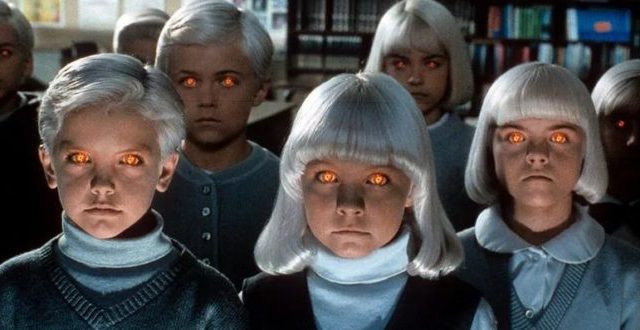Some Reading for Your Sugar Comas About:
- scary kids
- scary satire
- scary headlines
- scary fandoms
- scary art
- the most Scarry writer!
Thanks to scb0212, Casper and Miller for scaring up contributions this week. Send articles throughout the next week to ploughmanplods [at] gmail, post articles from the past week below for discussion and Have a Happy Friday!
The Guardian‘s Amelia Tait talks to former child actors in iconic horror roles:
When Danielle Keaton was seven, her homework was to open her eyes as wide as possible and stare. She had just secured a role in director John Carpenter’s Village of the Damned – a horror film about inhuman psychic children with violent tendencies – and had to perfect her creepy glare. […] “I always knew we were acting, it was playing.” Nothing negative sticks in her head, though something negative did stick out of it. “My hair was long, dark black, and they cut it really short and bleached it platinum blond,” she says. “My hair really did get damaged, it’s so sad.”
At Reverse Shot, Justin Stewart makes a pitch for the cheap thrills and sick satire of The Stuff:
The Stuff’s brisk production didn’t leave time for rehearsals or luxuries like sync sound, so much of the dialogue has the deadened, uncanny quality specific to ADR—ideal for a world in which humanity is being scooped out and replaced by what it’s putting in its stomach. Every statement and movement is so odd that, as in Invasion of the Body Snatchers, you’re never sure who’s been Stuffed. …While much of the film is too goofy to be truly scary, Jason’s parents (Frank Telfer and Collette Blonigan) genuinely unsettle, as when the father tries to reassure his cynical tot that it’s normal for humans to eat living things, citing (correctly) live bacteria in yogurt and yeast organisms, adding in monotone with a robotic grin, “They kill the bad things inside us.” Later, in praise of their Stuff diet, he enthuses, “We don’t need to sleep anymore!”
Maya Salam makes a visual compilation of exposition announced by newspaper headlines in horror and disaster movies at The New York Times:
Newspapers survive in a tangible way, unlike the final broadcasts on television and radio, which are also frequent tropes in the genre. And in post-apocalyptic worlds where power grids are largely nonexistent, digital trails also vaporize. There will probably be no screenshots to communicate society’s unraveling. […] So as fewer newspapers land on our neighbors’ doorsteps and as newsstands become obsolete, seeing front pages onscreen is almost as anachronistic as it is nostalgic — even if the news is that the undead are walking among us.
At The Guardian, Alan Moore expounds on his prescient position on fan cultures in the world:
Ten years on, let me make my position clear: I believe that fandom is a wonderful and vital organ of contemporary culture, without which that culture ultimately stagnates, atrophies and dies. At the same time, I’m sure that fandom is sometimes a grotesque blight that poisons the society surrounding it with its mean-spirited obsessions and ridiculous, unearned sense of entitlement. Perhaps this statement still requires some breaking down.
At the same publication Stephen Smith speaks of spooky gothic style in the paintings of modern art pioneers:
One of the best-known works in the show is a painting that Van Gogh made as a student: it’s a head-and-bony-shoulders of a skeleton, with a smouldering cigarette clamped between its teeth. Its mordant swagger feels very contemporary: it could have been made last week, perhaps by Banksy or Damien Hirst. It’s an exceptional loan from the Van Gogh Museum in Amsterdam, where it’s the most popular artwork among young visitors. Art history has tended to treat Skull of a Skeleton With Burning Cigarette (1885-6) as a juvenile joke, says Von Bonsdorff. “But this clearly recalls the Danse Macabre, a subject explored by Dürer and Holbein. We know from Van Gogh’s letters to his brother Theo that he was looking at Holbein and thinking about him at the time he painted the smoking skull.”
Chris Ware praises the genius of Richard Scarry at The Yale Review:
Scarry continued to produce books for another two decades, all of them featuring animals in place of humans. This actually caused a mild panic at Random House when What Do People Do All Day? was being published, with the staff asking: Shouldn’t it be called What Do Animals Do All Day? The dispute was short-lived since the answer (“No!”) was so obvious, but it hints at something important about the narrative energy on which Scarry’s engine runs. In children’s books, animals are frequently introduced as the first vessels to receive the natural empathy with which children are born. …The natural inclination to ask “do animals feel the same things we do?” is confirmed with a smile and a tuck-in, what in literary terms is cumbersomely called “anthropomorphization” but in everyday words is just “caring.”

